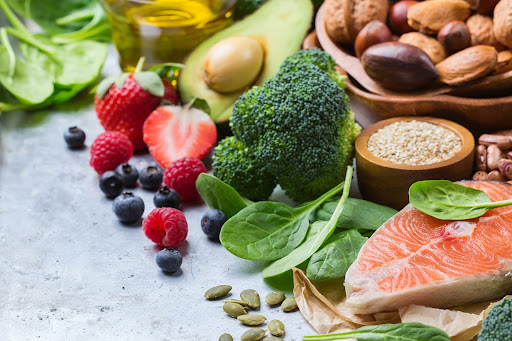The Paleo diet, also known as the Caveman or Stone Age diet, is a nutritional plan that emphasizes consuming foods that our ancestors ate in the Paleolithic era. This coincides with the period 2.5 million to 10,000 years ago when people had a simpler, more natural and nutrient-oriented diet that gave them energy and kept them disease free.
The popularity of the Paleo diet increased in the 2000s, with Dr. Cordain’s influential book which promoted the idea that you would be healthier by eating foods you were designed to eat. This idea isn’t new. Famous American gastroenterologist Walter Voegtlin was the true pioneer of the Paleo diet and wrote a book about it in 1975.
What made the “Stone Age” diet so popular?
The Paleo diet stands out due to its unique principles and approach. For example, the Paleo diet’s focus on ancient eating habits means that it emphasizes food BEFORE the advent of agriculture. This means that Paleo even excludes things like grains and legumes, which emerged much later and completely changed the food culture of our ancestors.
Apart from that, the Paleo diet is all about nutrient-dense foods that provide high-quality proteins, healthy fats, vitamins, minerals and antioxidants. It shifts focus from calorie-based diets to wholesome eating habits based on natural, unprocessed foods.
The core belief of the Paleo diet is that harmonious and healthy living should not go against evolutionary principles and human needs. And it goes beyond the food. The Paleo way of living stresses the importance of good sleep, physical exercise, and stress reduction – all of the things we lack in the modern world.
If one were to describe the Paleo diet in a few words, it would be nutrient-dense, whole foods,unprocessed, protein-rich and anti-inflammatory. Unlike other diets, the Paleo diet doesn’t prescribe a particular macronutrient ratio. Paleo diet won’t tell you that your plate should be high-protein, low-fat, high-fat and low-carb. Instead, the emphasis is on a well-balanced diet that is free of grains, lactose and legumes.

What are some of the misconceptions about the Paleo diet?
- The first misconception is that the Paleo diet is strictly meat-based. While meat is the primary source of protein in the Paleo diet, the diet includes consumption of fruits, vegetables, nuts, seeds and healthy fats.
- Another misconception is that the Paleo diet rejects carbs. While the Paleo diet excludes carbs like refined grains and sugars, it doesn’t believe that all carbs are bad. Some of the acceptable sources of carbs include fruits, vegetables, starchy tubers, like sweet potato, etc.
- Misconception #3 is that the Paleo diet is a low-carb diet. As I mentioned before, the Paleo diet doesn’t try to impose restrictions on certain macronutrients. It doesn’t tell you to cut out carbs or fats, but to consume everything in a balanced way. Yes, it’s true that the Paleo diet includes less carbs than the average Western diet, but it isn’t because Paleo forbids its consumption. It’s because Western diet is too reliant on unhealthy sources of carbs.
- Some say that the Paleo diet is the same as the ketogenic diet, because they both emphasize whole foods, healthy fats and proteins. However, a ketogenic diet is a high-fat, low-carb diet that tries to promote ketosis – getting body fuel mostly from fats, instead of glucose. The Paleo diet doesn’t do that.
- A big misconception is that the Paleo diet is only for those who want to lose weight. While weight loss can be a positive side effect of the Paleo diet, the goal of this way of life is to promote overall health and wellness by eating healthy, whole-foods. Some also say that because the Paleo diet eliminates certain sources of foods that modern humans actively consume (like legumes, grains and dairy), it is impossible to follow the Paleo diet for extended periods of time. While it might be difficult to give up things like melted cheese, the diet emphasizes the importance of quality ingredients. So, if you have to make substitutions based on personal needs and preferences, you have to make sure that what you’re eating is nourishing your body, not depleting it.
- Finally, we shouldn’t forget that the Paleolithic diet differed across the world. Our ancestors lived in different parts of the world and had access to different food sources. Available ingredients also change with seasons. So, your goal shouldn’t be to replicate the menu of a prehistoric man, but to understand the eating habits of people before humans started changing the nature of food and consume nutrient dense, unprocessed foods.
While I mentioned the basics of the Paleo diet, let’s describe it more systematically and outline the foods that you should avoid if you want to follow this diet. Then we’ll see what science and scientific evidence has to say about the Paleo way of life.
The Paleo diet primarily consists of:
- Lean meats: grass-fed or wild game meats, poultry, and fish as a source of protein. Eggs are also part of the Paleo food basket
- Fruits and vegetables for carbohydrates, fiber, vitamins and minerals
- Nuts and seeds for healthy fats and nutrients that are important for energy and satiety
- Healthy fats like avocado, olive oil and coconut oil. Many other oils are NOT part of the Paleo diet as they appeared much later and have no nutritional value
While it’s pretty standard that these ingredients are good for you, the Paleo diet has a quite long and somewhat surprising list of foods you should avoid. Here’s what you shouldn’t eat according to the Paleo diet:
- Grains like wheat, rice, oats and other cereal grains
- Legumes like beans, lentils and peanuts
- Dairy products, with the exclusion of grass-fed high quality butter or ghee
- Refined sugars and artificial sweeteners. Honey and maple syrup can be allowed but in moderation
- Processed foods due to the fact that they include additives and preservatives
- Vegetable oils like corn oil, canola, soybean due to their high omega-6 content. Omega-6 fats can be converted into arachidonic acid which promotes inflammation, blood clotting and other diseases
By following these food recommendations, you are on a path to reducing inflammation in your body, because all of the Paleo foods are anti-inflammatory and exclude allergens and irritants that can often lead to progression of chronic inflammatory based illnesses. I have talked a lot about the dangers of chronic inflammation which can be related to foods we consume and cause life threatening disease and accelerate aging.
Here’s what scientific evidence has to say about the Paleo diet:
- Emphasis on whole foods, healthy fats and lean proteins helps control your appetite and promotes weight loss. There is evidence that the Paleo diet improves glucose tolerance more than the Mediterranean diet and improves cardiovascular health.
- It improves digestion by removing common allergens like gluten, lactose, etc. Replacing these foods with healthy superfoods can transform your gut and overall health. The goal of the Paleo diet is to stop stressing your body by ingesting human-made foods that have no analogue in the natural world. You can follow this golden rule – if it doesn’t exist in nature, you probably shouldn’t be eating it. There is ample evidence that the paleo diet is great for metabolism as well.
- Better blood sugar control – is it a surprise that eliminating all the processed, poisoned sweets will lower your glycemic load and stabilize your blood sugar levels and even improve your mood?
I can not stress enough what a Paleo diet can do for your mental clarity. Many of us often feel like we are living in a constant state of brain fog, where we’re withdrawn from the things happening around us. We complain about our memory problems, inability to concentrate and enjoy simple pleasures. By cutting out heavily processed foods you can regain your mental clarity and focus – which is the key to a happy and successful life.
I believe that we should move away from a culture that is very food centric and pleasure driven to viewing food as a fuel for our body and mind that will give us energy and allow us to create happy moments in life. It’s really worth it.
To your health,
Dr. John Dempster, ND

